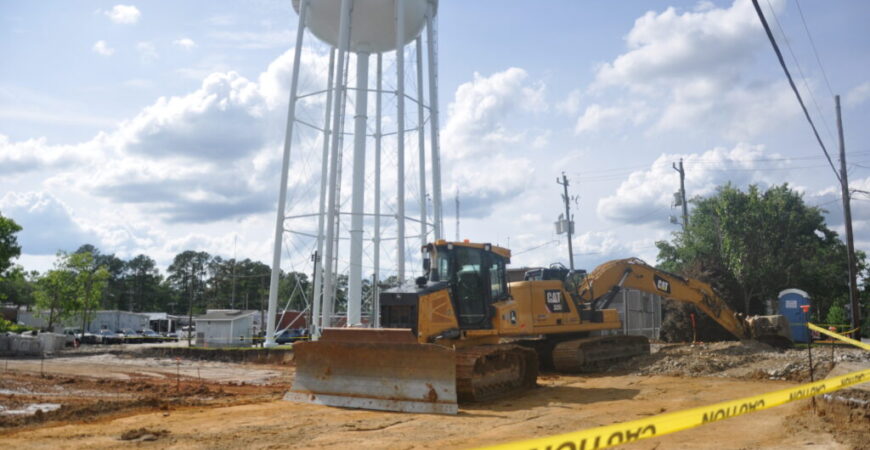WALLACE — Starbucks, Wawa and Dunkin’— oh my! Rumors surrounding what new businesses are coming to Wallace have circulated since before the town’s 2024 acquisition of 150 acres in Pender County, and have been given fuel following the start of construction on its $20 million airport improvement project and $5 million fire station earlier in the year. In an effort to separate fact from fiction, Duplin Journal recently sat down with Planning Director Rod Fritz to discuss the factors driving the town’s commercial and residential growth, what these developments mean for Wallace residents, and how new state legislature could impede the small town in achieving its aspirations for expansion.
Several factors contribute to the town’s attractiveness as an investment for commercial companies and residential builders, according to Fritz, including its ability to grow its infrastructure.
“A lot of little towns are at their full capacity in their sewage treatment plants. We’re blessed that we have a plant that’s only running at I think 40-50% capacity, so we’re able to entice housing and commercial development to Wallace.” Another reason, he says, is the town’s location. “We’ve got three exits off of I-40 that add to the allure.”
Fritz explained that Wallace’s proximity to large, vital municipalities like Wilmington and Raleigh, coupled with its accessibility to the interstate, could further draw the eye of potential investors.
“Wilmington’s becoming an expensive place to live,” added Fritz. “I used to live there 30-something years ago. A nice home, you could buy for $300,000 – $350,000 — now, that’s starter home stuff.” For those looking to move away from urban environments to more rural, small-town locales, Wallace may seem like a neat place to be.
“We’re still growing — we’re on the very beginnings of becoming urban,” said Fritz. “A lot of the agricultural fields we see around will maybe become developed in the future, and maybe Tin City grows out towards River Landing.”
The planning director confirmed that in addition to the roughly 1,000 new homes on the books, the town is already experiencing some commercial growth.
“From a commercial standpoint, the ones that are permitted — not rumors — but the ones that are permitted are: Starbucks, Dunkin’ Donuts, Chick-fil-A, WaWa gas station, and Royal Farms fuel station,” he said, adding that the new Snappy Lube on Highway 41 is already doing business. “Just north of Tin City, all the way up to Henderson Road, is going to be residential growth.”
Fritz advised that over 300 homes were projected within that area.
In addition to over 40 home sites in the western half of Eastwood Acres that will soon be for sale, there will be 600 quarter-acre home sites on the 150 acres of land the town annexed from Pender County in 2024, with the potential for even more commercial development.
“There’s rumors of all kinds of other projects coming, but I hate to spread rumors until I see plans. That just stirs people up,” said Fritz. “The way I understand the marketing is, our Walmart is right at about $80 million a year in sales. Certain businesses, the big box stores like Lowes, Home Depot, Lone Star Steakhouse, Outback, Texas Roadhouse, those kinds of places start looking at a community when their Walmart does $100 million.”
While Fritz feels that the prospect of future development is good for the community overall, he acknowledges that not everyone may view the town’s projected growth in a similar light. “It might be bad for some small business entrepreneurs who own smaller hardware stores and stuff close by that now have to compete with Lowes or Home Depot.”
Growth could have other adverse impacts, according to Fritz, specifically regarding Interstate 40, Highway 41, Highway 117, and Highway 11. “Transportation is gonna be the biggest one because the major arteries that run through Wallace are not under our control — they’re state highways,” advised the planning board director, indicating that communication between the municipality, the developer’s needs and North Carolina Department of Transportation (NCDOT) is of paramount importance to avoid congestion as the town grows. “That’s why we just did a brand new bicycle and pedestrian master plan.”
The plan, currently awaiting approval by the NCDOT for entry into their State Transportation Improvement Program, or STIP, could set the town up for funding toward pedestrian paths, bicycle routes and road improvement in 2028. Fritz also indicated that the town has requested developers in residential areas to leave a right-of-way or easement for the future implementation of alternative transportation routes, such as a greenway bicycle path.
“There’s some alternatives that are being thought about while this growth is happening to make us more like a community that thinks holistically about recreation and transportation, and alternative transportation. Gasoline’s not going to get any cheaper — probably,” said Fritz. “Those things are important. You’re thinking about a city as it grows up that’s fun to live in, fun to work in, and fun to play in.”
While the small town’s projected growth seems inevitable, the planning director says proposed state legislation could hinder or otherwise complicate efforts to facilitate its further development and challenge the expansion of small communities throughout North Carolina.
“Senate Bill 493 is the one that’s potentially out there to take away the ETJ of small towns in counties with populations of less than 50,000,” advised Fritz. An ETJ, or extra-territorial jurisdiction, is an area outside of a municipality that is still subject to its zoning and building regulations. Without them, Fritz says, those places located outside of the city’s zoning limits “basically become the Wild Wild West” — potentially resulting in hog farms next to residential areas or adult bookstores near highway exits. As the county currently has no zoning in place for the town’s ETJ, a building moratorium may be implemented until they’ve established a zoning plan for the area.
“Then there’s House Bill 661 — House Bill 661 would impact our planning jurisdiction by limiting our control over land use regulation. More specifically, it restricts our ability to negotiate what we call conditional zoning.” Fritz advised without the ability to negotiate, local municipalities would need to turn to quasi-judicial special use permits that he feels introduces another unnecessary level of bureaucracy.
House Bill 765, another bill that could impede progress in small towns, “Creates a patchwork of mandates that, in my opinion, bans local common sense land use practices,” said Fritz. “It will eliminate the decision-making powers of our local governments and their voters. Basically, subjecting everybody to legal penalties if they don’t follow the new laws, just for routine planning decisions.”
Lastly, House Bill 876, titled Development Application Review Timelines — or, as Fritz calls it, the “shock-clock bill” — will drastically shorten the residential development application in building permit review times. “If you don’t issue the permit in 90 days, it’s automatically good. And there are certain processes like the rezoning process that take us 90 days in order to complete.” The bill also allows developers to hire third-party reviewers to review those permits.
“It’s a fox in a hen house thing — let’s just say it like it is. If you’ve got somebody that you’re hiring to review your building permit, who’s to say you’re not giving them a little on the side money to approve it?” said Fritz. “I don’t like it. It’s taking authority away from communities in order to guide their own development.”
 Twitter
Twitter Facebook
Facebook Instagram
Instagram





